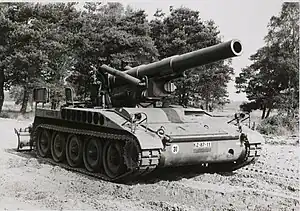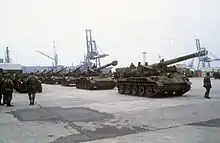M110 howitzer
The 8 inch (203 mm) M110 self-propelled howitzer is an American self-propelled artillery system consisting of an M115 203 mm howitzer installed on a purpose-built chassis. Before its retirement from US service, it was the largest available self-propelled howitzer in the United States Army's inventory; it continues in service with the armed forces of other countries, to which it was exported. Missions include general support, counter-battery fire, and suppression of enemy air defense systems.
| 8" M110 self-propelled howitzer | |
|---|---|
 M110 203 mm self-propelled howitzer of the Royal Netherlands Army | |
| Type | Self-propelled artillery |
| Place of origin | United States |
| Service history | |
| Wars | Vietnam War Yom Kippur War Iran–Iraq War 1982 Lebanon War Kurdish–Turkish conflict (1978–present) Gulf War |
| Production history | |
| Manufacturer | General Motors (transmission)[1] |
| Specifications | |
| Mass | 28.3 t (27.9 long tons; 31.2 short tons) |
| Length | 35 ft 5 in (10.8 m) |
| Width | 10 ft 2 in (3.1 m) |
| Height | 10 ft 2 in (3.1 m) |
| Crew | 13 (driver, 2 gunners, 2 loaders, (8 support crew–other vehicle)) |
| Caliber | 203 mm (8.0 in) |
| Barrels | 1 |
| Effective firing range | 16.8–25 km (10.4–15.5 mi) RAP 30 km (19 mi) |
| Armor | .51 in (13 mm) |
Main armament | 8 in (203 mm) M201A1 howitzer |
Secondary armament | none |
| Engine | Detroit Diesel 8V71T, 8-cylinder, 2-stroke, turbocharged diesel 405 hp (302 kW) |
| Suspension | Torsion bar |
| Maximum speed | 30 mph (54.7 km/h) |
Description
According to the operator's manual, the M110's typical rate of fire was three rounds per two minutes when operated at maximum speed, and one round per two minutes with sustained fire. The M110 featured a hydraulically operated rammer to automatically chamber the 200 lb (91 kg)+ projectile. These rammers were prone to breakdown and generally slowed operation of the gun because the rammers required crews to completely lower the massive barrel before using it. Well trained and motivated crews could achieve two to four rounds per minute for short periods by using the manual rammer, essentially a heavy steel pole with a hard rubber pad on one end. Using the manual rammer was physically demanding, but crews were not required to lower the barrels as much as with the hydraulic rammer.
The M110's range varied from 10.4 mi (16.8 km) to approximately 16 mi (25 km) when firing standard projectiles, and up to 19 mi (30 km) when firing rocket-assisted projectiles.[2]
History
The M110 howitzer first entered service with the U.S. Army in 1963 and was used in the Vietnam War by the United States Army. Later versions were used in the Gulf War - Operation Desert Shield and Operation Desert Storm by Tango Battery 5th Battalion 11th Marines, and the British Army's 32nd Regiment Royal Artillery.[3]
In 1977 the upgraded M110A1 entered service, featuring a longer M201 series barrel which gave an increased range. The M110A2 is the latest version with a double muzzle brake, in contrast to the earlier A1 version which had a plain muzzle. The 2nd Battalion 18th Field Artillery (U.S. Army) which inactivated in 1994 at Fort Sill, Oklahoma, and the 5th Battalion 18th Field Artillery served in Desert Storm with the M110A2 Howitzer, as well as the 142nd Field Artillery Brigade (Arkansas Army National Guard), and 1st BN 181 Field Artillery (Tennessee Army National Guard). Most of the U.S. Army and USMC relied on the M109 series 155-millimeter howitzer gun systems during this conflict; sending remaining M110s to reserve or National Guard units. These units then took possession of M109s as they returned from service in the Gulf. M110s were still in service with the 3/92 FA (USAR) and running fire missions at Camp Atterbury as late as the summer of 1994.[4]
The howitzer has been retired from U.S. Army service having been replaced by the M270 Multiple Launch Rocket System.
The M110A2s were made from refitted M110s or M107 175 mm SP guns[5]

At the end of the Cold War under U.S. Division Plan 86, all armored and mechanized infantry divisions included a battalion of heavy artillery that included two batteries of M110A2 SP howitzers with six guns each for a total of 12 guns, plus one battery of nine M270 Multiple Launch Rocket System rocket artillery.
Israel used M110s along with M107s during Yom Kippur War against Egyptian and Syrian forces. Again in 1982 Operation Peace for Galilee, Israel used M110 systems against PLO and Lebanese allies with deadly effect during Siege of Beirut.
Iran used its M110s during Iran–Iraq War against Iraqi forces during its offensives against Iraq.
Turkish Armed Forces have used M110A2 systems against Kurdistan Workers' Party since the 1990s and during Turkish military intervention in Syria, mainly against People's Protection Units.
Projectiles

- M14 dummy
- M106 HE
- M650 HE rocket assist projectile (RAP)
- M509 ICM
- M404 ICM anti-personnel (airburst)
- M426 agent GB Sarin
- M422A1 Artillery Fired Atomic Projectile[6]
- M424 High Altitude Spotting Round for the M422 projectile
- XM753 Atomic RA (rocket assisted)[7]
Operators


Current operators
 Bahrain: Royal Bahraini Army 13 as M110A2 from Netherlands delivered in 1994,[8] 25 as M110A2 from US delivered in 1996.[9]
Bahrain: Royal Bahraini Army 13 as M110A2 from Netherlands delivered in 1994,[8] 25 as M110A2 from US delivered in 1996.[9] Cyprus: Cypriot National Guard 8 as M110A2[10]
Cyprus: Cypriot National Guard 8 as M110A2[10] Greece: Hellenic Army 145 as M110A2.
Greece: Hellenic Army 145 as M110A2. Egypt: Egyptian Army Received 144 as M110A2 as aid in 1996.[11]
Egypt: Egyptian Army Received 144 as M110A2 as aid in 1996.[11] Iran: Iran Army 30 M110.
Iran: Iran Army 30 M110. Japan: Japan Ground Self-Defense Force 91 as M110A2. As of 2023, approximately 10 M110A2 are in active, owned by 104th Artillery Battalion of 4th Artillery Brigade in Hokkaido. They are scheduled to be retired by March 2024.[12]
Japan: Japan Ground Self-Defense Force 91 as M110A2. As of 2023, approximately 10 M110A2 are in active, owned by 104th Artillery Battalion of 4th Artillery Brigade in Hokkaido. They are scheduled to be retired by March 2024.[12] Jordan: Jordanian Armed Forces 120 as M110A2.
Jordan: Jordanian Armed Forces 120 as M110A2. Morocco: Moroccan Army 60 as M110A2.
Morocco: Moroccan Army 60 as M110A2. Pakistan: Pakistan Army 140 in service as of 2021.
Pakistan: Pakistan Army 140 in service as of 2021. Taiwan: Republic of China Army 70 M110A2 as of 2023[13]: 291 [14]: 1021
Taiwan: Republic of China Army 70 M110A2 as of 2023[13]: 291 [14]: 1021  Turkey: Turkish Army currently phasing out 219 as M110A2 in favor of T-155 Fırtına
Turkey: Turkish Army currently phasing out 219 as M110A2 in favor of T-155 Fırtına
Former operators
.svg.png.webp) Belgium: Belgian Army 11 M110A2 between 1972 and 1993 used by the 20th Artillery Regiment (Belgian Forces in Germany).
Belgium: Belgian Army 11 M110A2 between 1972 and 1993 used by the 20th Artillery Regiment (Belgian Forces in Germany). Germany: German Army M110A2 until 1993.
Germany: German Army M110A2 until 1993. Israel: Israeli Army 36 as M110, retired in 1990s.
Israel: Israeli Army 36 as M110, retired in 1990s. Italy: Italian Army used M110A2s, phased out by 1998.
Italy: Italian Army used M110A2s, phased out by 1998. South Korea: Republic of Korea Army Operated M110 since 1961. Retired in the late 2000s after being replaced by K9 Thunder.[15]
South Korea: Republic of Korea Army Operated M110 since 1961. Retired in the late 2000s after being replaced by K9 Thunder.[15] South Vietnam: Army of the Republic of Vietnam.
South Vietnam: Army of the Republic of Vietnam. Netherlands: Royal Netherlands Army M110A1 and M110A2, replaced by the M109 in the 1990s
Netherlands: Royal Netherlands Army M110A1 and M110A2, replaced by the M109 in the 1990s Spain: Spanish Army as 64 M110A2, deployed in divisional fire support regiments until 2009.
Spain: Spanish Army as 64 M110A2, deployed in divisional fire support regiments until 2009. United Kingdom: British Army as M110A2 firing high explosive and nuclear shells only. (The FV433 Abbot SPG, the M109A2, and the M110A1 were replaced by the AS-90 in the early-mid-1990s.) Used in Operation Granby/Gulf War.[4]
United Kingdom: British Army as M110A2 firing high explosive and nuclear shells only. (The FV433 Abbot SPG, the M109A2, and the M110A1 were replaced by the AS-90 in the early-mid-1990s.) Used in Operation Granby/Gulf War.[4] United States: Used by United States Army and United States Marine Corps, M110A2s retired in 1994.
United States: Used by United States Army and United States Marine Corps, M110A2s retired in 1994.
See also
- List of U.S. military vehicles by model number
- 2S7 Pion – Soviet L/55.3 203 mm self-propelled cannon
- 2S4 Tyulpan – Soviet 240 mm self-propelled mortar
- List of crew served weapons of the US Armed Forces
- M55 – 203 mm self-propelled gun, predecessor to the M110
- M107 – a 175 mm self-propelled gun on the same chassis
- Sholef – Israeli 155 mm self-propelled howitzer
- T92 Howitzer Motor Carriage – a 240 mm howitzer M1 fitted on a M26 Pershing chassis
References
- Defense Industry Bulletin, April 1968, p. 47.
- "The M110 at Military-today.com".
- 32 Regiment RA in action - Gulf War 1991
- UK M110 Artillery in action Gulf War 1991
- (Hunnicutt).
- Thomas B Cochran; William M Arkin; Milton M Hoenig (1984). Nuclear Weapons Databook, Volume I: US Nuclear Forces and Capabilities (PDF) (Report). Natural Resources Defense Council. p. 47. Archived (PDF) from the original on 1 September 2021. Retrieved 22 June 2021.
- Henry E Hudgins (January 1977). Aerodynamics, Dimensions, Inertial Properties and Performance of Artillery Projectiles (PDF) (Report). Picatinny Arsenal. p. 4. Archived (PDF) from the original on 19 December 2021. Retrieved 24 December 2021.
- Stockholm International Peace Research Institute. "Transfers and licensed production of major conventional weapons". Retrieved 10 December 2011.
- Defense Security Cooperation Agency. "Excess Defense Articles". Archived from the original on 14 January 2012. Retrieved 10 December 2011.
- "Εξοπλισμός Εθνικής Φρουράς (Κύπρος)". www.ellinikos-stratos.com. Retrieved 3 July 2023.
- "Deals in the Works". Federation of American Scientists. Retrieved 29 March 2011.
- Yusuke, Tsuge. "陸自最大サイズの巨砲「203mm自走りゅう弾砲」まもなく退役 進む"火砲リストラ" 最後の部隊は". Vehicle news. Retrieved 28 September 2023.
- International Institute for Strategic Studies (February 2023). The Military Balance 2023. Routledge, Chapman & Hall, Incorporated. ISBN 978-1-032-50895-5. Retrieved 19 August 2023.
- Foss, Christopher F. (2005). Jane's Armour and Artillery 2005-2006. Jane's Information Group. ISBN 978-0-7106-2686-8. Retrieved 19 August 2023.
- Bak, Dongchan (March 2021). Korean War : Weapons of the United Nations (PDF) (in Korean). Republic of Korea: Ministry of Defense Institute for Military History. pp. 108–110. ISBN 979-11-5598-079-8. Archived (PDF) from the original on 9 October 2022.
- TM 9-2350-304-10 dated October 1979